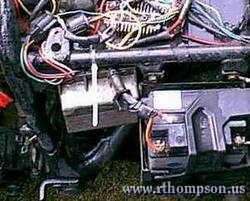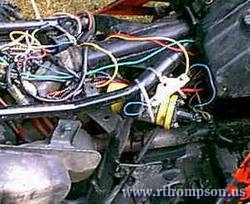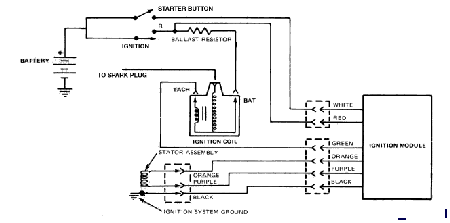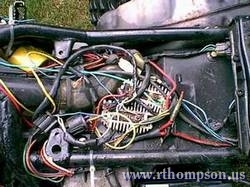How to Convert an ATV to Ford Ignition
 There was no way I was going to spend $280 on a cdi box for my Yamaha Moto-4 ATV. I knew how to wire up a Ford ignition since I had to figure it out earlier for my Jeep. It isn't very hard, and it is a lot more reliable than the cheaply made cdi boxes. I got the idea from an old website that no longer exists. It had a wiring diagram of how to wire a Ford Duraspark ignition module into an older Ford car or truck. There was nothing to it really; all that is needed is a regular Ford coil, a ballast resistor, and the Duraspark ignition module. You can probably get the whole mess including the wiring connectors from a junkyard for almost nothing. Wire the bike's regular stator wiring to the input wires of the Duraspark module, and wire the coil up as shown in the diagram. The ignition switch is going to have to be messed with to make it work again. I guess that is something that is different on a lot of bikes, so you will have to figure that part out on your own if you even bother with it. I took off the original key switch and disconnected the start button; then I wired the ignition and starter into a universal automotive key switch. The hardest thing I had to figure out was where to put the coil. I finally zip-tied it to the frame near the carb.
There was no way I was going to spend $280 on a cdi box for my Yamaha Moto-4 ATV. I knew how to wire up a Ford ignition since I had to figure it out earlier for my Jeep. It isn't very hard, and it is a lot more reliable than the cheaply made cdi boxes. I got the idea from an old website that no longer exists. It had a wiring diagram of how to wire a Ford Duraspark ignition module into an older Ford car or truck. There was nothing to it really; all that is needed is a regular Ford coil, a ballast resistor, and the Duraspark ignition module. You can probably get the whole mess including the wiring connectors from a junkyard for almost nothing. Wire the bike's regular stator wiring to the input wires of the Duraspark module, and wire the coil up as shown in the diagram. The ignition switch is going to have to be messed with to make it work again. I guess that is something that is different on a lot of bikes, so you will have to figure that part out on your own if you even bother with it. I took off the original key switch and disconnected the start button; then I wired the ignition and starter into a universal automotive key switch. The hardest thing I had to figure out was where to put the coil. I finally zip-tied it to the frame near the carb.
 If the thing barely runs above idle after it is wired up, reverse the wires on the stator. If they are backwards, it retards the timing a lot. Also the ignition pulls more power than stock, so be careful running lights or other accessories. The best thing about that ignition on an ATV is that you almost can't flood the thing or make the plug foul up. I put an Accel Super Coil on mine for a little extra kick. It is still a lot cheaper than any Yamaha coil. I opened the gap on the plug to .050, and it doesn't miss a bit.
If the thing barely runs above idle after it is wired up, reverse the wires on the stator. If they are backwards, it retards the timing a lot. Also the ignition pulls more power than stock, so be careful running lights or other accessories. The best thing about that ignition on an ATV is that you almost can't flood the thing or make the plug foul up. I put an Accel Super Coil on mine for a little extra kick. It is still a lot cheaper than any Yamaha coil. I opened the gap on the plug to .050, and it doesn't miss a bit.
One thing I noticed after using this ignition for awhile is that the battery runs down after a long period of low engine speed. I hooked an ammeter to it and found out that the charging circuit only puts out a small amount of power, something like 5 amps running the engine wide open. The ignition pulls about 2 amps, so you have to have the engine running about 1800 RPM before the thing charges the battery. So if you idle around a lot like I do, that is kind of a problem. One thing that worked on this engine that I figure is the same on most of them is that the original cdi box had a separate coil in the engine to power it. I checked the voltage and current coming from it, and it was a pretty high voltage but not much current. I took the coil out of the engine and found that it was wound with a lot of turns of small gauge wire. I rewound it with a slightly larger gauge than the charging coil was wound with and put as many turns on it as I could without causing it to rub. I put an old diode out of a Chevy alternator on it and connected it to the battery. Now at idle the 2 charging coils put out enough power so that running the original headlight, the ignition, and a pair of 35w halogen lights on it puts about .03A into the battery at idle. Anything above idle puts a good charge into the battery. Now I should be able to run about anything else I want and have the power to keep the battery charged.
 I have had that ignition on it now for a while, and the only problems I have had were from my wiring job. I originally wired the whole thing using one color of wire; needless to say, I had a mess when a wire messed up. I gave up and rewired it using a lot of different colors. After that, it never has had any trouble from the ignition. I noticed that it knocked a little under heavy load, so I hooked a timing light to it and found the timing was too far advanced. I dug some resistors out of some old junk electronics and put them on the stator wiring (purple and orange). I started the thing up and kept trying different resistors until I got the timing back to where it was supposed to be. I liked the extra power the advanced timing had, so I wired a toggle switch to the resistors. This way I could turn the advance back up when I wanted a little extra power for going up a hill. As for the resistors, I settled on a 1k ohm resistor between the wires and a small capacitor from each wire to ground to get rid of any electrical noise from the wires. Depending on the bike, you might need to hook a small resistor (about 33 ohms) in series on one or both wires. Also the white wire can be eliminated. It retards the ignition when starting, so it is only needed if the ignition bumps the starter hard enough to keep the engine from turning over easily.
I have had that ignition on it now for a while, and the only problems I have had were from my wiring job. I originally wired the whole thing using one color of wire; needless to say, I had a mess when a wire messed up. I gave up and rewired it using a lot of different colors. After that, it never has had any trouble from the ignition. I noticed that it knocked a little under heavy load, so I hooked a timing light to it and found the timing was too far advanced. I dug some resistors out of some old junk electronics and put them on the stator wiring (purple and orange). I started the thing up and kept trying different resistors until I got the timing back to where it was supposed to be. I liked the extra power the advanced timing had, so I wired a toggle switch to the resistors. This way I could turn the advance back up when I wanted a little extra power for going up a hill. As for the resistors, I settled on a 1k ohm resistor between the wires and a small capacitor from each wire to ground to get rid of any electrical noise from the wires. Depending on the bike, you might need to hook a small resistor (about 33 ohms) in series on one or both wires. Also the white wire can be eliminated. It retards the ignition when starting, so it is only needed if the ignition bumps the starter hard enough to keep the engine from turning over easily.
I hope that some other people get this working because I hate to see people waste so much money on a thing like an easy-to-break cdi box when there are things that are so much cheaper and better. The new coil and ignition box can be put in for less than $50, and I know that it is a lot stronger. I did this mod in 1998 for anyone that is curious and I ran the 4 wheeler up through about 2009. It finally gave up from just being wore out and not being worth fixing. The duraspark was still running strong.